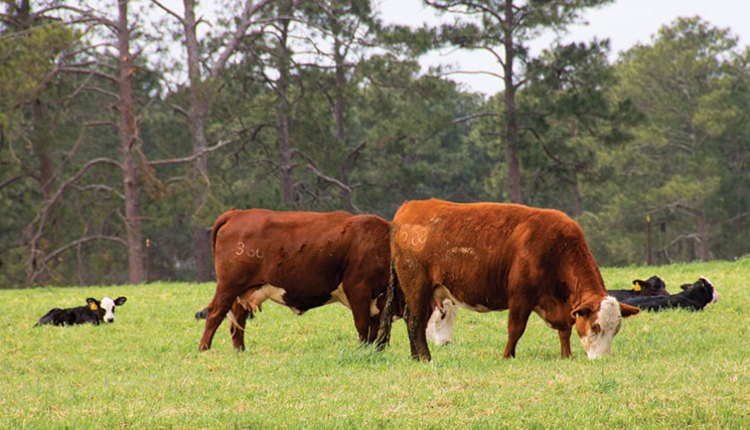The author is with Iowa State University Extension and is a program specialist at the Iowa Beef Center in Ames.


Spring is officially here. Some beef producers have finished calving while others are just getting started. Regardless, understanding how to match your available forage to your herd’s nutritional needs is important going forward into the growing season.
From early April to late May, the week-to-week change (quality and quantity) in pastures is rapid throughout the Midwest. Initially, ensure lactating cows have enough to eat given short forage height and the high forage moisture content. Also, be mindful to not negatively impact pasture productivity going forward. These and other early spring grazing challenges need to be addressed early for season-long grazing success.
Thankfully, this early spring timeline is fairly short as pastures change to belly-deep grass in a hurry. By the end of May and early June, instead of dealing with short, early growth, producers need to have a plan to manage the influx of available forage often termed the “spring flush.” Of course, this assumes moisture wasn’t limiting.
We know that the quantity of forage will likely be available for the cows, but maintaining enough quality so that it meets a breeding cow’s requirements and keeps herd performance acceptable is the challenge. Data presented in Iowa Cow-calf Production – Exploring Different Management Systems was collected and summarized from summer pasture samples taken from multiple producers throughout the state over two years. On average, pastures provided enough protein for a 1,400-pound lactating cow, and energy was sufficient in most months.
The majority of pastures in this study were composed of cool-season grasses with some legumes. For forages, the biggest factor influencing nutritive value is maturity. To maintain grass quality, the key is to keep the grass vegetative.
One effective method for maintaining a vegetative state is rotational grazing. This can be intensive rotational grazing or rotating between a few paddocks. Strategic timing to mow a pasture can also be used to keep grass vegetative for a longer period of time. In the Midwest, tall fescue is an important and prominent grass species. Chaparral is an example of an herbicide that also suppresses fescue seedheads from developing, which extends the vegetative timeline and reduces the likelihood of fescue toxicosis.
It’s a challenge to effectively utilize the tonnage of grass grown in the spring flush before grass quality declines, and the summer slump reduces growth. The most common method of using the large quantity of grass is to defer grazing in a set number of paddocks or pasture acres and then harvest it as hay when it reaches the boot to dough stage. The harvested hay can be stored and fed in winter, early spring before grass growth is adequate, or it can be a good feed option for freshly weaned calves in the fall.
Consider stockers
Running stocker calves is a flexible option that offers the ability to graze excess grass in the spring and early summer, and then sell calves or put them in a feedyard as grass growth declines. The available grass can result in cheap gains, though the amount gained can be influenced by several factors.
Keep in mind that stocker calves are putting on a large portion of their weight in muscle. This requires protein, and the type of protein influences weight gain. The protein in forages is mostly rumen degradable protein (RDP). The other main type of protein is rumen undegradable protein (RUP).
The general analogy nutritionists use to differentiate between these is that RDP feeds the microbes, and RUP travels to the small intestine and is used by the animal. It’s not quite this straightforward, but for a young animal putting on muscle, a strategic RUP supplement can help the animal gain more efficiently on a high-forage diet. Energy supplementation, utilizing a low potency implant, and feeding an ionophore through mineral are all strategies that can improve stocker gains on pasture.
Many assume that providing a supplement allows the pasture to have a higher carrying capacity. Though not wrong, the amount of supplement fed determines if forage intake will be reduced or not. Iowa Beef Center data shows that supplementing mature cows and stocker calves at less than 0.5% of the animal’s body weight did not displace any forage consumption. However, when supplementation rose to greater than 1% of the animal’s body weight, the forage consumption declined by as much as 26%. In addition, a supplementation program when grazing on fescue-dominant pasture enhances performance due to its mitigating effects on fescue toxicity.
Prepare for the slump
For producers grazing stockers, or simply stocking cow numbers high enough to take advantage of the abundance of forage in the spring, an option to keep carrying capacity high through the “summer slump” period is to plant some warm-season annual forages and incorporate them into the grazing rotation. After the plethora of prevent-plant acres last year, and with the looming questions around markets, more producers have considered alternative forage crops. These give producers more flexibility and options to boost carrying capacity through the summer.
Even though management is needed to capitalize on the value of your spring and early summer pastures, this time of year is a favorite for beef producers.

